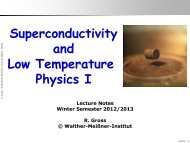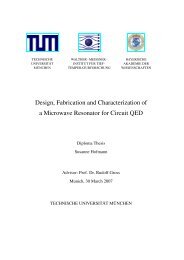Applied Superconductivity - Walther Meißner Institut - Bayerische ...
Applied Superconductivity - Walther Meißner Institut - Bayerische ...
Applied Superconductivity - Walther Meißner Institut - Bayerische ...
- No tags were found...
Create successful ePaper yourself
Turn your PDF publications into a flip-book with our unique Google optimized e-Paper software.
Section 4.1 APPLIED SUPERCONDUCTIVITY 179The application of both flux modulation and bias current reversal is called double modulation technique.It can reduce the low-frequency 1/ f -noise of SQUIDs based on high temperature superconductors byseveral orders of magnitude. 46,47Additional Positive Feedback: An important reason for the use of the flux modulation technique is thefact that the voltage changes δV (Φ ext ) (typically less than 100 µV/Φ 0 ) and the SQUID impedance (typicallya few Ω) are small. This is inadequate for semiconductor devices. Applying the flux modulation,the SQUID impedance can be increased by a step-up transformer and matched to the room temperaturesemiconductor electronics. An alternative way is to use the additional positive feedback (APF) technique,in which part of the bias current is used to obtain an asymmetric V (Φ ext ) dependence with a steepslope and hence larger value for ∂V /∂Φ. In this case a direct read-out of the SQUID signal with lownoise room temperature semiconductor electronics is possible. 48,49Additional Topic:Digital Read-Out SchemesFujimaki et al. 50 and Drung et al. 51,52 have developed schemes in which the output from the SQUIDis digitized and fed back to the SQUID as an analog signal to flux-lock the loop. Fujimaki et al. usedJosephson digital circuits to integrate their feedback system on the same chip as the SQUID. Drunget al. obtained a flux resolution of about 10 −6 Φ 0 / √ Hz in a 50 pH SQUID. They were also able toreduce the 1/ f noise by using a modified bias current modulation scheme. In general, the cryogenicdigital feedback schemes have the advantage that they are compact, offer wide flux-locked bandwidthand produce digitized output signals for transmission to room temperature.Additional Topic:The Relaxation Oscillation SchemeMück and Heiden have operated a dc SQUID with hysteretic junctions in a relaxation oscillator. 53 Here,the SQUID is shunted by a series connection of an inductor and resistor. The circuit performs relaxationoscillations at a frequency depending on the flux in the SQUID. The oscillation frequency has a minimumfor (n + 1 2 )Φ 0 and a maximum for nΦ 0 with a typical frequency modulation of about 100 kHz at anoscillation frequency of about 10 MHz. The advantage of this scheme is that it produces a large voltageacross the SQUID so that no matching network to the room temperature electronics is required. The roomtemperature electronics is allowed to be simple and compact. A flux resolution of about 10 −5 Φ 0 / √ Hzfor a 80 pH SQUID operated at 4.2 K has been achieved. The so-called double relaxation oscillationSQUID (DROS) is briefly addressed in section 4.3.1.46 R.H. Koch, W. Eidelloth, B. Oh, R. P. Robertazzi, S. A. Andrek, and W. J. Gallagher, Appl. Phys. Lett. 60, 507 (1992).47 A.H. Micklich, D. Koelle, E. Dantsker, D. T. Nemeth, J. J. Kingston, R. F. Kroman, and J. Clarke, IEEE Trans. Appl.Supercond. 3, 2434 (1993).48 D. Drung, Physica C 368, 134 (2001).49 D. Drung, in SQUID Sensors: Fundamentals, Fabrication and Applications,NATO Science Series E: <strong>Applied</strong> Sciences, Vol. 329, Kluwer Academic Publishers, Dordrecht, Boston, London (1996).50 N. Fujimaki, H. Tamura, T. Imamura, S. Hasuo, ISSCC San Francisco, (1988), pp. 40-41.51 D. Drung, Cryogenics 26, 623-627 (1986).52 D. Drung, E. Crocoll, R. Herwig, M. Neuhaus, W. Jutzi, IEEE Trans. Magn. MAG-25, 1034-1037 (1989).53 M. Mück, C. Heiden, IEEE Trans. Magn. MAG-25, 1151-1153 (1989).2005
















